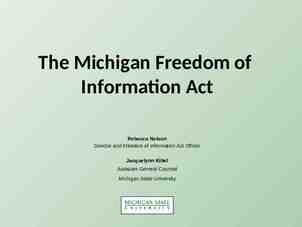JRTC and Fort Polk Defensive Driving Information
11 Slides922.00 KB
JRTC and Fort Polk Defensive Driving Information
Department of Defense Instruction (DODI) 6055.4, DoD Traffic Safety Program E3.3.1. All military personnel under 26 years of age who possess a driver's license shall be given a minimum of four hours of classroom instruction in traffic safety designed to establish and reinforce a positive attitude toward driving. Individual responsibility and correct response to routine and emergency driving situations shall be stressed. Such education should be given expediently after initial entry into Military Service. E3.3.2. Driver improvement courses shall be used at no cost to the individual. These courses shall reinforce positive attitudes and motivate persons who have been convicted of serious moving traffic violations, or who have been determined to have been at fault in a traffic accident while operating a Government-owned vehicle on or off a DoD installation. Offenders, military or civilian, shall be required to attend those courses or lose installation-driving privileges.
AR 385-55 Prevention of Motor Vehicle Accidents 3–2. Requirements for POV accident prevention a. Training. Commanders will ensure that their soldiers know the main causes of Army POV accidents. (1) Four-wheel motor vehicles. Major topics to be covered include the following: (a) Causes of accidents (b) Emotions and accident causation (c) How to avoid a collision with another vehicle (d) The effects of drugs and alcohol on driving skills. (e) How to control fatigue when driving (f) Pedestrian safety precautions (g) Driver’s view of motorcycling Appendix B Highway Safety Program Standards, B–4. Driver education (HSPS No. 4) a. All personnel (Active Army, U.S. Army Reserves, Army National Guard, and civilian) required to drive AMVs will be given classroom instruction in accident avoidance. This instruction will be designed to establish and reinforce a positive attitude toward the driving task
AR 600-55 Army Driver and Operator Standardization Program Chapter 2 Driver Application, 2–1. License requirements a. This chapter identifies licensing requirements of applicants for motor vehicle operator positions. b. All Active Army, ARNG, U.S. Army Reserve (USAR), and civilian personnel (excluding contractor personnel) to include foreign nationals will be trained, tested, and issued an OF 346 (U.S. Government Motor Vehicle Operator’s Identification Card) according to this regulation. c. Driver applicants for administrative, tactical, or emergency wheeled vehicles, to include those whose positions will require the transport of hazardous materials, will complete training equal to or greater than that specified in chapter 4 of this regulation. Chapter 4 contains waivers relating to training and testing requirements for specific vehicles and under certain conditions. Motorcycle, moped, and all– terrain vehicle (ATV) operators must also comply with the provisions of AR 385–55. d. No exceptions to this regulation will be made in the case of persons who regularly operate vehicles or equipment in connection with other work or incident to other duties. A person employed either as a part–time or full–time operator for the Army must successfully complete the appropriate series of required tests. e. Civilians appointed under direct–hire authority in cases of Office of Personnel Management (OPM) registers, reinstatements, position changes or transfers, and noncompetitive job appointments must comply with the provisions of this regulation.
FORSCOM Regulation 385-1 Forces Command Safety Program 1-8 Responsibilities: c. Commanders will establish and operate an effective safety/ accident prevention program to include the following program elements. (2) Privately owned and Army motor vehicle accident prevention program. JRTC & Ft Polk Regulation 385-7 Save Our Soldier (SOS) POV Accident Prevention PARA 3. a(4)(a) All soldiers who operate POVs, to include All Terrain Vehicles (ATVs) and motorcycles, will attend appropriate driver safety courses, ATV Safety Institute (ASI) Course, and Motorcycle Foundation Institute Safety Course). The Driver Safety course is only valid for 4 years. All DoD civilians who are required by their duties to drive an ATV will attend the ASI course. Units will maintain a record of all individuals who have attended the above mentioned courses.
Command Policies S-2, Physical Training S-4, Consumption of Alcohol S-5, DWI Policy S-12, Operation Forewarn S-11, Noise Abatement S-17, Head Protection for Tactical Vehicles (Will be incorporated into JRTC & FP Regulation 385-4) S-23, Leave and Pass Policy(Will be incorporated into JRTC & FP Regulation 385-7) L-16, Fatality and Serious Accident Review Committee (Will be incorporated into JRTC & FP Regulation 385-4)
HOT SPOTS In and Around Fort Polk Highway 28 (Death Alley) More Soldiers have died on HWY 28 than any other highway Construction Highway 10 Texas Avenue and Highway 10 Dead-Man’s Curve Highway 117 Entrance Road and Highway 171 Highway 467 and Louisiana Intersection Highway 171 and McDonald’s (Leesville) Belrichard and Alabama or Georgia Intersections (Fort Polk)
LAWS IF YOUR WIPERS ARE ON, YOUR HEAD LIGHTS MUST BE ON HEADLIGHTS MUST BE ON IF VISIBILITY IS RESTRICTED TO 50 FEET OR LESS NO ONE IS AUTHORIZED TO RIDE IN THE BED OF A PICK UP TRUCK ON FORT POLK LOUISIANA DOES NOT REQUIRE MOTORCYLCE RIDERS TO WEAR HELMETS; HOWEVER, DEPARTMENT OF DEFENSE DOES REQUIRE MILITARY TO WEAR APPROVED HELMETS. THIS IS NOT AN OPTION. MOTORCYLE MAY NOT BE REGISTERED ON POST UNLESS THE OWNER HAS COMPLETED AN APPROVED MOTORCYLE RIDER SAFETY COURSE
SOS REQUIREMENTS INDIVIDUAL RISK ASSESSMENT Conducted by first line supervisor Initial arrival to unit and every six months All soldiers PRE PASS/LEAVE BRIEF Conducted by first line supervisor Prior to pass/leave/TDY/PSC/ETS All soldiers VEHICLE INSPECTION Conducted by first line supervisor Prior to long weekend, pass or leave All soldiers POV ACCIDENT INVESTIGATION (ALL POV ACCIDENTS WILL BE INVESTIGATED BY UNIT) {JRTC & FT POLK REG 385-7, PARA 3.b.} POV ACCIDENT PREVENTION TTT WILL BE PROVIDED BY THE SAFETY OFFICE ON REQUEST (JRTC & FT POLK REG 385-7, PARA 3.a.(6)(g))
TRENDS Approximately 50 Accidents per Month Accidents Normally Occur Between 2300 - 0600 hrs Main Cause of Accidents and Injuries Speed DWI Fatigue Loss of Control No Use of Seatbelts Aggressive Driving Peak Periods of Traffic 0600 - 0800 Hrs (Heavy period) 1100 - 1300 Hrs 1600 1800 Hrs (Heavy period)
Cost of DWI What it May Cost You Here for Your 1st Offense Known Costs 450.00 Fine Downtown 100.00 For Other Charges 100.00 Bond 60.00 Towing 130.00 Cost of Court 100.00 DWI Counterattack Course Unknown Costs Amount for Transportation (no license) Amount for Community Service (what’s your time worth?) Amount for reduction in grade (varies depends on your grade) Average Cost 1ST TIME OFFENDER 1400.00
















